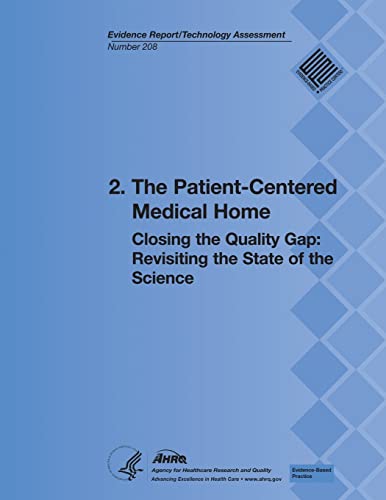Items related to 2. The Patient-Centered Medical Home: Closing the Quality...
2. The Patient-Centered Medical Home: Closing the Quality Gap: Revisiting the State of the Science (Evidence Report/Technology Assessment Number 208) - Softcover

The United States spends a greater proportion of its gross domestic product on health care than any other country in the world (17.6 percent in 2009), yet often fails to provide high quality and efficient health care. U.S. health care has traditionally been based on a solid foundation of primary care to meet the majority of preventive, acute, and chronic health care needs of its population; however, the recent challenges facing health care in the United States have been particularly magnified within the primary care setting. Access to primary care is limited in many areas, particularly rural communities. Fewer U.S. physicians are choosing primary care as a profession, and satisfaction among primary care physicians has waned amid the growing demands of office-based practice. There has been growing concern that current models of primary care will not be sustainable for meeting the broad health care needs of the American population. The patient-centered medical home (PCMH) is a model of primary care transformation that seeks to meet the variety of health care needs of patients and to improve patient and staff experiences, outcomes, safety, and system efficiency. The term “medical home” was first used by the American Academy of Pediatrics in 1967 to describe the concept of a single centralized source of care and medical record for children with special health care needs. The current concept of PCMH has been greatly expanded and is based on 40 years of previous efforts to redesign primary care to provide the highest quality of care possible. The chronic care model, a conceptual model for organizing chronic illness care that is associated with improved health outcomes, is the cornerstone of PCMH. Interventions based on the chronic care model (CCM) and focused on single conditions such as diabetes mellitus, asthma, chronic obstructive pulmonary disease, or depression have been shown to improve patient outcomes and/or quality of care. PCMH builds on this model and is intended to address the full range of patient-focused health care needs. As defined by physician and consumer groups, the core principles of the PCMH are wide-ranging team-based care, patient-centered orientation toward the whole person, care that is coordinated across all elements of the health care system and the patient’s community, enhanced access to care that uses alternative methods of communication, and a systems-based approach to quality and safety. As part of the Closing the Quality Gap: Revisiting the State of the Science series of reviews by Evidence-based Practice Centers (EPCs), this systematic review was commissioned to identify completed and ongoing efforts to evaluate the comprehensive PCMH model, summarize current evidence for this model, and identify gaps in the evidence. Because the PCMH model is being implemented widely but the number of completed studies was expected to be small, the identification of ongoing studies was an important goal of this review. The Key Questions include: KQ 1. In published, primary care–based evaluations of comprehensive PCMH interventions, what are the effects of the PCMH on patient and staff experiences, process of care, clinical outcomes, and economic outcomes? KQ 2. In published, primary care–based evaluations of comprehensive PCMH interventions, what individual PCMH components have been implemented? KQ 3. In published, primary care–based evaluations of comprehensive PCMH interventions, what financial models and implementation strategies have been used to support uptake? KQ 4. What primary care–based studies evaluating the effects of comprehensive PCMH interventions on patient and staff experiences, process of care, clinical outcomes, or economic outcomes are currently underway? In these ongoing studies, what are the study designs, PCMH components, comparators, settings, financial models, and outcomes to be evaluated?
"synopsis" may belong to another edition of this title.
- PublisherCreateSpace Independent Publishing Platform
- Publication date2013
- ISBN 10 1483935329
- ISBN 13 9781483935324
- BindingPaperback
- Number of pages216
Buy New
Learn more about this copy
US$ 45.20
Shipping:
US$ 2.64
Within U.S.A.
Top Search Results from the AbeBooks Marketplace
2. the Patient - Centered Medical Home : Closing the Quality Gap: Revisiting the State of the Science (Evidence Report/Technology Assessment Number 208)
Published by
CreateSpace Independent Publishing Platform
(2013)
ISBN 10: 1483935329
ISBN 13: 9781483935324
New
Softcover
Quantity: 5
Seller:
Rating
Book Description Condition: New. Seller Inventory # 20482935-n
Buy New
US$ 45.20
Convert currency
2. The Patient-Centered Medical Home: Closing the Quality Gap: Revisiting the State of the Science (Evidence Report/Technology Assessment Number 208)
Published by
Createspace Independent Publishing Platform
(2013)
ISBN 10: 1483935329
ISBN 13: 9781483935324
New
Paperback / softback
Quantity: > 20
Seller:
Rating
Book Description Paperback / softback. Condition: New. This item is printed on demand. New copy - Usually dispatched within 5-9 working days. Seller Inventory # C9781483935324
Buy New
US$ 36.70
Convert currency
2. the Patient - Centered Medical Home : Closing the Quality Gap: Revisiting the State of the Science (Evidence Report/Technology Assessment Number 208)
Published by
CreateSpace Independent Publishing Platform
(2013)
ISBN 10: 1483935329
ISBN 13: 9781483935324
New
Softcover
Quantity: 5
Seller:
Rating
Book Description Condition: New. Seller Inventory # 20482935-n
Buy New
US$ 36.69
Convert currency

